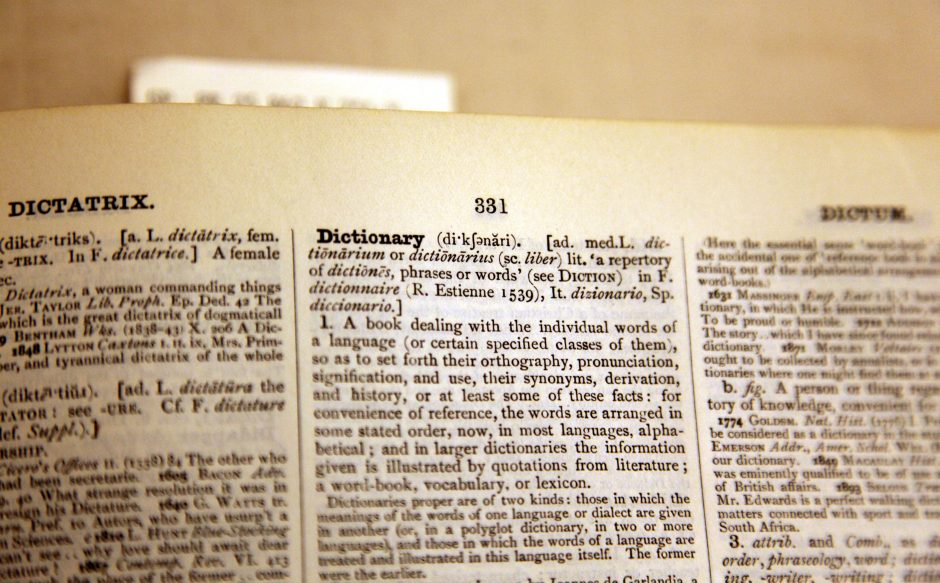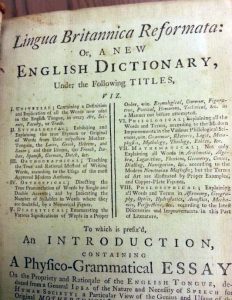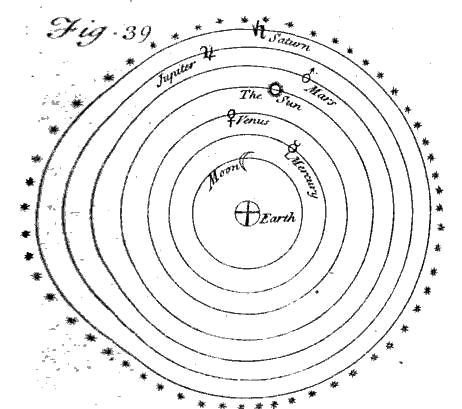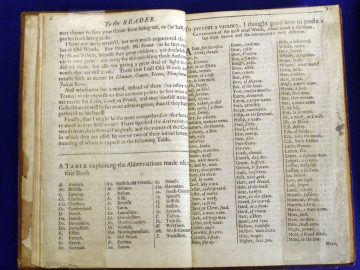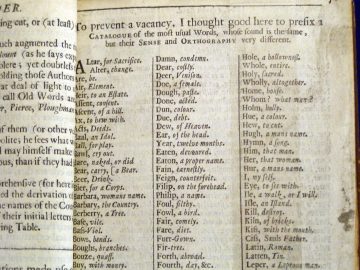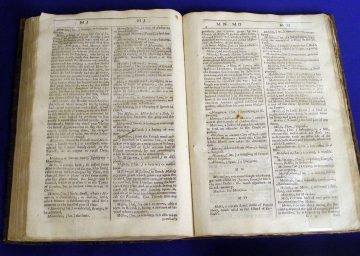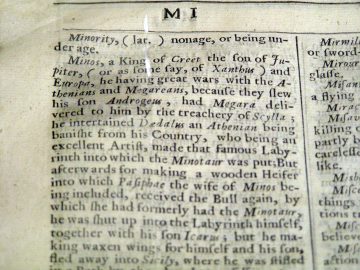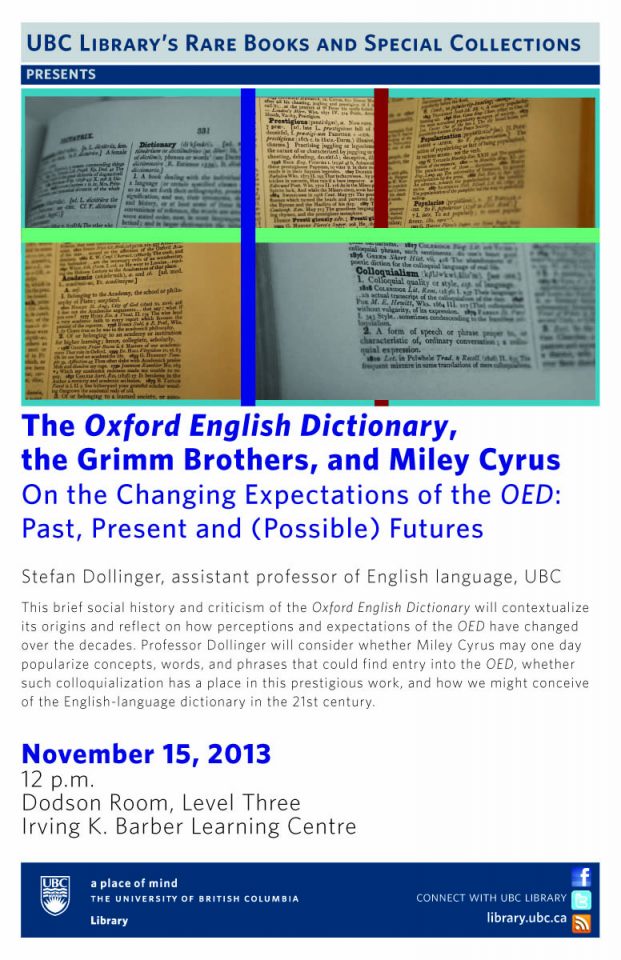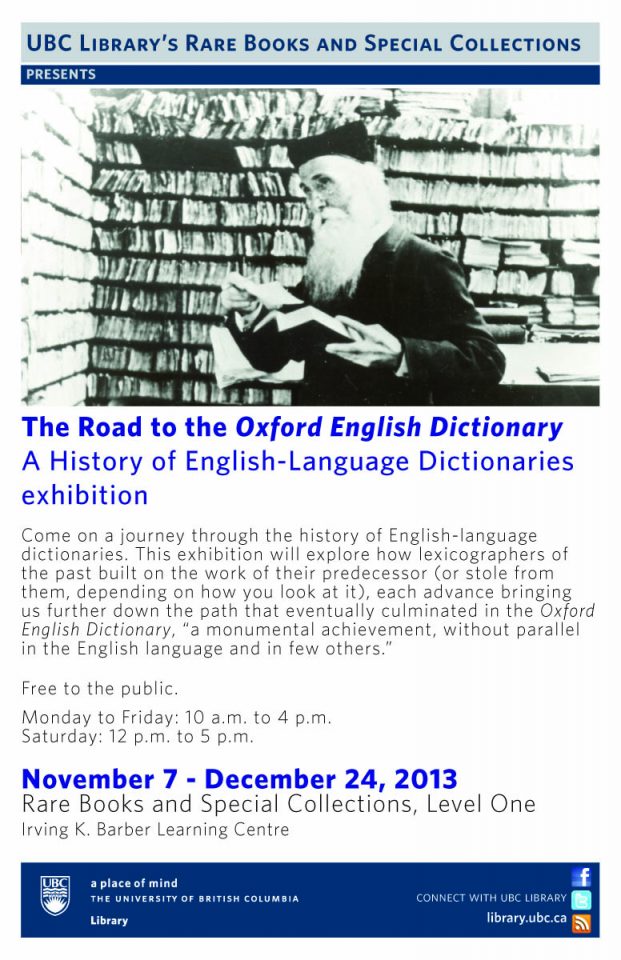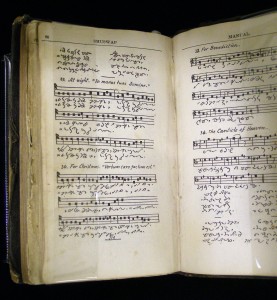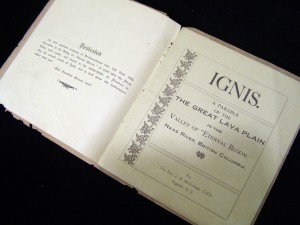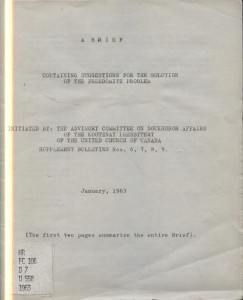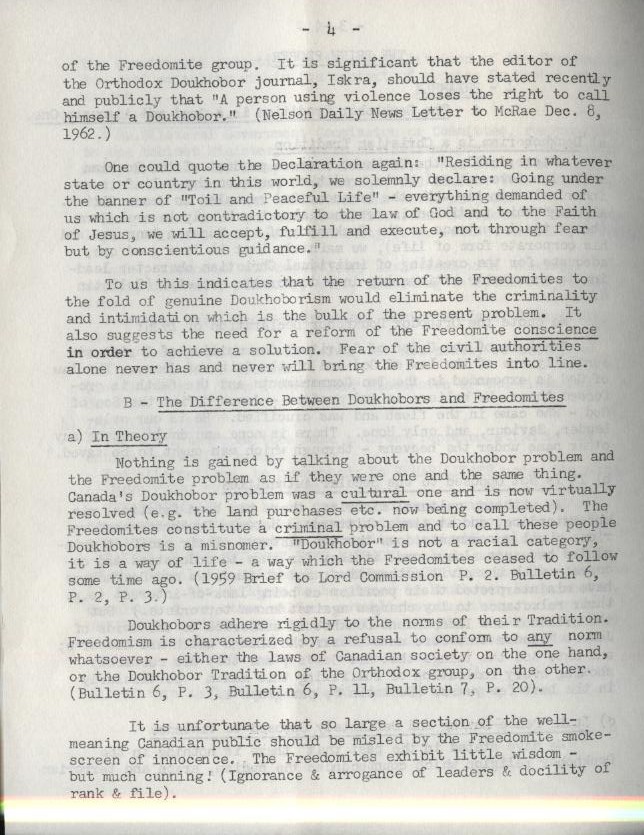Sorry you missed it?
Posted on February 28, 2017 @2:52 pm by cshriver
If you’ve been quietly sobbing into your copy of the Compact Oxford English Dictionary since missing last Friday’s talk by Professor Stefan Dollinger, dry your eyes! Iva Cheung, a local professional editor and a current student in the UBC course English 320: History of the English Language, wrote a terrific blog post about the event, which provides a summary of the talk and some of her thoughts. Thanks so much for coming, Iva, and for blogging!
No CommentsPosted in Announcements, Events, Uncategorized | Tagged with
Thanks for joining us!
Posted on February 28, 2017 @2:53 pm by cshriver
Many thanks to everyone who attended Professor Dollinger’s talk last Friday on the past, present, and possible future(s) of the Oxford English Dictionary. It was entertaining, insightful, and provided lots of food for thought. Even if you weren’t able to make it to the talk, the related exhibition, The Road to the OED: A History of English-Language Dictionaries, will be on display in Rare Books and Special Collections until December 24. We hope you stop by!
Now for this week’s student dictionary report from the course English 320: History of the English Language.
Martin, Benjamin. Lingua Britannica Reformata, or, A New English Dictionary. London: Printed for J. Hodges [etc.], 1749. PE25 .R62 V. 234
Benjamin Martin (bap. 1705, d. 1782), the author of Lingua Britannica Reformata, or, A New English Dictionary (1749), was a man known for being “remarkable for his successful versatility” (Millburn 2004). “In an age when it was still possible for one man to comprehend virtually all branches of science,” John Millburn writes in his biography of Martin, “he was the supreme non-specialist” (Millburn 1976, 2). Indeed, Martin was not only a lexicographer, but also a teacher, lecturer, eyeglass-specialist, and microscope-maker. In fact, for most of his life, his main occupation was lecturing on Newtonian physics. He began writing books with the intention of lowering the price of books, as he wanted to ensure that people could educate themselves through reading. Having been born the son of a farmer, books were his gateway to knowledge, and apparently it was through extensive reading that Martin came to understand the various subjects he later taught when he opened up a school in Sussex with his wife (Martin 2004).
Lingua Britannica Reformata is but one of his many publications, and it was published twice, once in 1749 and again in 1754 (Millburn 2004). He wrote it with several aims in mind, which are listed at the beginning of the dictionary. A particularly interesting aim was that of UNIVERSALITY. By this, Martin meant that he intended to achieve a “just Mean” between “useless and obsolete Words” and “those which are useful and necessary” (Martin 1749, iv) – in other words, fairly represent words that are commonly used in English language, regardless of their potentially lower prestige. He believed in the importance of accurately reflecting the English language of his time as it was most commonly used, and did not share the same concern for preserving antique forms and words that other lexicographers may have had. Nevertheless, he understood the importance of linguistic history, and he spent a great deal of effort on etymology in both the preface to the dictionary and in the actual entries themselves. He argued that knowing a word’s etymology was crucial for a clearer understanding of the word’s signification, and thus provided Greek, Hebrew, French, or Latin roots for words where he could, occasionally glossing the meaning of the root word.
An interesting insert in the dictionary that is worth looking at is the collection of geometrical and astronomical diagrams that he included in the back of the dictionary, likely because of his own expertise in those subjects. Martin was undoubtedly a fascinating figure of his time, and continues to be remembered for being an excellent polymath.
— Kerong Lin (English 320: History of the English Language, 2012-2013)
Millburn, John R. Benjamin Martin: author, instrument-maker, and country showman. Leyden: Noordhoff International Pub, 1976.
Millburn, John R. “Martin, Benjamin (bap. 1705, d. 1782).” John R. Millburn In Oxford Dictionary of National Biography, online ed., edited by Lawrence Goldman. Oxford: OUP. http://www.oxforddnb.com.ezproxy.library.ubc.ca/view/article/18175 (accessed April 4, 2013)
No CommentsPosted in Events, Exhibitions, Uncategorized | Tagged with
The OED and Miley Cyrus?!
Posted on February 28, 2017 @2:54 pm by cshriver
So what does Miley have to do with the Oxford English Dictionary, you may ask? If anyone can tell us, it’s UBC’s Professor Stefan Dollinger. Professor Dollinger will be giving a talk this Friday, November 15, at 12 p.m. entitled:
The Oxford English Dictionary, the Grimm Brothers, and Miley Cyrus
On the Changing Expectations of the OED: Past, Present and (Possible) Futures
In addition to contextualizing the origins of the OED, Professor Dollinger will consider whether Miley Cyrus may one day popularize concepts, words, and phrases that could find entry into the OED, whether such colloquialization has a place in this prestigious work, and how we might conceive of the English-language dictionary in the 21st century.
The talk will be the Dodson Room on level three of the Irving K. Barber Learning Centre at UBC. Bring your lunch and join us for what promises to be a fascinating talk!
Now for this week’s student dictionary report from the course English 320: History of the English Language.
Coles, Elisha. An English Dictionary. London: Printed for Peter Parker, 1685. PE25 .R62 V. 102
Dictionaries play an essential role in the history of English lexicography. They keep not only a record of our vocabulary, but also a record of our culture and our beliefs. An English Dictionary Explaining the Difficult Terms by Elisha Coles is a wonderful dictionary that offers contemporary readers a glance into the past and at the changes in the English language.
Coles was born around 1640 and died in 1680. He was a lexicographer, a stenographer, and a schoolmaster in London. He is best-known for his dictionary. There are a total of 13 editions of the dictionary published between in 1676 and 1732. Since 1732, it has been reprinted many times (the most recent reprint is in 2011). Between 1500 and 1650, there was an influx of new words borrowed into English from Latin or Greek, or distant countries that English traders had visited, leading to a growing need for English dictionaries as the English lexicon became difficult for many English-speakers. Nonetheless, the earliest monolingual dictionaries were not general-English-language dictionaries, but “hard word” dictionaries that explained difficult and foreign words. Although the title contains “difficult terms,” this was the first dictionary to shift towards becoming a general-purpose dictionary by including a broader variety of materials, such as canting terms (also called criminal slang).
As Coles’ dictionary is one of the earliest monolingual English dictionaries, it is not surprising that it does not have many of the features that contemporary dictionaries do (e.g., part-of-speech, subject label). Nevertheless, it has many noteworthy features not found in modern dictionaries. For example, it includes a catalogue of homophones from which we can see evidence of sound change (e.g., “are,” “air,” and “heir” are listed together, suggesting that “are” may have sounded like “air”). Also, on the last page, there are seven tables of measure (e.g., a table of Troy-weight, of Aver du pois Weight), exemplifying the intensity of language-mixture and culture-mixture during the 17th century as a French table of weight is included in a monolingual English dictionary. The tables of measure are different from today’s measures as well (e.g., “13 years, 1 day and 6 hours” makes “1 year very near”). Furthermore, the dictionary illustrates a period of transition in orthography (i.e., its own content alternates between using “s” and long “s,” and –t and –ed past tense inflection). Overall, although An English Dictionary does not have many of the dictionary features found in modern dictionaries, it has its own unique features which reflect the interests and concepts of its time. Providing a glimpse into the past, it is a valuable dictionary not only for the 17th century but also for the 21st century and probably for many centuries to come.
— Skylet Yu (English 320: History of the English Language, 2012-2013)
Posted in Announcements, Events, Exhibitions, Uncategorized | Tagged with
Time to hit the road…The Road to the OED!
Posted on February 28, 2017 @2:55 pm by cshriver
A new exhibition, The Road to the OED: A History of English-Language Dictionaries, is now up in Rare Books and Special Collections!
This exhibition features work done by seven students from the course English 320: History of the English Language. For this class, Professor Laurel Brinton asked each student to select one dictionary from the H. Rocke Robertson Collection of Dictionaries, to research the author of the dictionary, and to report on the features of the dictionary in the context of the history of English lexicography–the activity or occupation of compiling dictionaries. We were delighted to include these reports and the dictionaries that inspired them in in our exhibition, and each week, we will be posting one student report and photos of the dictionary on our blog. We hope this inspires you to stop by to see the rest of the exhibition, or simply to take a little extra time to appreciate the humble dictionary the next time you look up a word!
You can visit the exhibition at Rare Books and Special Collections on the first floor of the Irving K. Barber Learning Center from 10 a.m.-4 p.m., Monday-Friday, and from 12-5 p.m. on Saturdays until December 24, 2013.
Phillips, Edward. The New World of English Words: or, A General Dictionary. London: Printed by E. Tyler, for Nath. Brooke at the Sign of the Angel in Cornhill, 1658. PE25 .R62 V. 260
First published in 1658, Edward Phillips’ New World of English Words has the distinction of being the first folio English dictionary. In terms of content, it is firmly placed in the tradition of dictionaries of “hard words” initiated with Robert Cawdrey’s A Table Alphabeticall of 1604. As the title states, the work contains “the Interpretations of such hard words as are derived from other Languages; whether Hebrew, Arabick, Syriack, Greek, Latin, Italian, French, Spanish, British, Dutch, Saxon, &c. their Etymologies and perfect Definitions.” Phillips then goes on to offer a long list of specialized disciplines and sciences whose terms will be explained in the dictionary, including “Theologie,” “Physiognomy,” “Jewelling,” and “Husbandry,” and adds that the reader will also find “The significations of Proper Names, Mythology, and Poetical Fictions, Historical Relations, Geographical Descriptions of most Countries and Cities of the World.” As with all dictionaries of this kind, the main difference between the New World and modern lexicographical works is the conspicuous absence of common, everyday words. This was standard practice at the time, and would only begin to change with the publication of Samuel Johnson’s A Dictionary of the English Language in 1755.
Entries in the New World are extremely straightforward: the headword appears in italics, and the definition follows. What Phillips calls the “etymology” is a parenthetical indication of the language of origin which occurs between the headword and the definition in most but not all entries. The style and the content of the definitions themselves are fairly inconsistent. A definition can range from one word, like “exalted” for Mary, to a list of synonyms, like “weaknesse, indisposednesse” for Infirmity, to a short explanation, like “a calling aside, a drawing apart” for Sevocation, to what amount to brief encyclopaedic entries, like that for Minos. If we compare these entries with those in modern dictionaries we notice again that much is lacking. Phillips does not provide a pronunciation guide, for example, a feature which is particularly missed in a dictionary composed almost exclusively of rare words, usually of foreign origin. Neither is the part of speech indicated, though most words—again, as with most “hard words” dictionaries—are either nouns or verbs. The etymological aspect, as has been said, is extremely deficient, and, in fact, does not even meet the standard set by Phillips’ own definition of the word as “a true derivation of words from their first Original.” Lastly, as we would expect, Phillips does not make use of illustrative quotations, nor does he seem at all to be interested in usage, as evidenced by the fact that he makes use of a small group of “learned Gentlemen and Artists,” which he lists at the beginning of the work, as sole authorities for his definitions.
Though the New World was a popular and successful dictionary, it is unlikely that it made any impact on the development of the discipline of lexicography, save perhaps as being part of that tradition which writers such as Johnson were trying to improve upon. Phillips’ was an unoriginal work, both in design and in content—he plagiarized a considerable number of his definitions from Thomas Blount’s earlier Glossographia—and it is safe to say that it was partly with the New World in mind that the Earl of Chesterfield declared in 1754 that “our dictionaries at present [are] more properly what our neighbours the Dutch and the German call theirs, word-books, than dictionaries in the superior sense of that title.”
— Javier Ibáñez (English 320: History of the English Language, 2012-2013)
No CommentsPosted in Announcements, Exhibitions, Uncategorized | Tagged with
The Oxford English Dictionary, the Grimm Brothers, and Miley Cyrus
Posted on February 28, 2017 @2:54 pm by cshriver
Please join us for a talk sponsored by Rare Books and Special Collections at UBC Library.
The Oxford English Dictionary, the Grimm Brothers, and Miley Cyrus
On the Changing Expectations of the OED: Past, Present and (Possible) Futures
Stefan Dollinger, assistant professor of English language at the University of British Columbia and editor-in-chief of The Dictionary of Canadianisms on Historical Principles
Friday, November 15, 2013
12 p.m.
Dodson Room, Irving K. Barber Learning Centre
University of British Columbia
The Oxford English Dictionary is one of the longest-running academic projects in history. Commenced in the early Victorian period and funded by Oxford University Press since its inception, it represents a grand achievement in English letters. As such, the OED commands a lot of prestige: when completed in 1928, no less illustrious personage than the British prime minister was the guest of honour, and Oxford University bestowed honorary degrees upon its publishers. As with any large-scale project, fair criticism can be hard to come by—one may take for granted that the OED is the apex in the field. While such claims may be hard to defend today, due credit must be given to a project that has navigated any and all rough seas for over one and a half centuries.
Professor Stefan Dollinger will offer a brief social history and criticism of the OED. Contextualizing its origins, he will consider how perceptions and expectations of the OED have changed over the decades. Today, the OED is popularly considered to list all English words, from William Shakespeare to Miley Cyrus, though such comprehensiveness was never its goal. While Miley Cyrus has as yet little to contribute to word coinage, her current notoriety and media exposure creates the possibility that she may one day popularize concepts, words, and phrases that could find entry into the OED: or shouldn’t they? This potential exemplifies the colloquialization and popularization of the OED that has already commenced. Beyond the impact of individual celebrities, the major question concerning the OED today revolves around how to conceive of the dictionary in the 21st century. Now that English is spoken by (far) more second language speakers than first language speakers, will the OED adapt to the new realities?
Free and open to the public.
For more information, please contact Rare Books and Special Collections at 604 822-2521 or rare.books@ubc.ca, and visit the exhibition The Road to the OED: A History of English-Language Dictionaries from November 7-December 24, 2013.
No CommentsPosted in Announcements, Events, Uncategorized | Tagged with
The Road to the OED: A History of English-Language Dictionaries
Posted on February 28, 2017 @2:54 pm by cshriver
Rare Books and Special Collections at UBC Library announces an upcoming exhibition!
The Road to the OED: A History of English-Language Dictionaries
Join Rare Books and Special Collections on a journey through the history of English-language dictionaries. This exhibition will explore how lexicographers of the past built on the work of their predecessor (or stole from them, depending on how you look at it), each advance bringing us further down the path that eventually culminated in the Oxford English Dictionary, “a monumental achievement, without parallel in the English language and in few others.”
November 7—December 24, 2013
The exhibition will be open Monday through Friday, 10 a.m. to 4 p.m., and Saturday, 12 p.m. to 5 p.m., at Rare Books and Special Collections on the first floor of the Irving K. Barber Learning Centre.
Free and open to the public.
For more information, please contact Rare Books and Special Collections at 604 822-2521 or rare.books@ubc.ca.
2 CommentsPosted in Announcements, Exhibitions, Uncategorized | Tagged with
Charles van Sandwyk and the Children’s Literary Tradition
Posted on October 9, 2013 @11:37 am by kalsbeek
UBC Library’s Rare Books and Special Collections (RBSC) is pleased to present, Charles van Sandwyk and the Children’s Literary Tradition. Curated by Kristy Woodcock (a Masters of Library Science and Information Studies student at the School of Library, Archival and Information Studies at UBC). Featuring material from UBC Rare Books and Special Collections and private collections, this exhibition explores the art of Charles van Sandwyk in the context of the children’s literary tradition. Charles van Sandwyk is a talented artist in a long and distinguished tradition of authors and illustrators, and he follows in the footsteps of masters such as Arthur Rackham, Beatrix Potter, and Ernest Shepard with his drawings of fairies, anthropomorphic animals, and dream worlds.
The exhibition, from October 1-31, 2013, is located in RBSC, on level one of the Irving K. Barber Learning Centre, and is open to the public Monday to Friday, 10am to 4pm, and Saturday, 12pm to 5pm.
As part of this exhibition, Charles van Sandwyk will be reading from his selections of his work on Wednesday, October 30, 2013 from 12:00 p.m. – 1:30 p.m, in the Dodson Room (Rm 302), Irving K. Barber Learning Centre, University of British Columbia. This event is free of charge, and is open to the public. Refreshments will be served. As well, there will be book sales by the Joyce Williams Gallery.
For information and tours contact please contact RBSC: 604-822-2521
No CommentsPosted in Announcements, Exhibitions, Uncategorized | Tagged with
A mystery solved- the Adolphus Lindgren fonds
Posted on July 23, 2013 @10:11 am by sromkey
We were contacted recently by author David Charles Manners, who is a descendant of Albert Lindgren. In January 2011 we announced on our blog that we had acquired a documentary art collection of sketches and watercolours by Albert Lindgren, a ship captain who lived in Vancouver near the turn of the 20th century. When David came across the collection, he was surprised- while his great-great-great-grandfather, Adolphus Lindgren, was a hobby watercolourist, to his knowledge his great-great-grandfather, Albert Lindgren, did not share his father’s artistic interests.
We were able to send scans of the (unsigned) sketches and watercolours to David who was able to confirm for us that we had gotten the provenance of this collection wrong- these are definitely watercolours of his 3+-great grandfather Adolphus. We have since updated our catalogue records to reflect this information, and thank David very warmly for both spotting the mistake, and providing us with biographical information about Adolphus!
No CommentsPosted in Collections, Uncategorized | Tagged with
The Return of “The Iron Pulpit”!
Posted on February 27, 2018 @9:22 am by kalsbeek
As part of UBC Library’s commemoration of Canada’s National Aboriginal History Month, Rare Books and Special Collections (RBSC) is pleased to present the return of last fall’s popular exhibition “The Iron Pulpit”: Missionary Printing Presses in British Columbia. The exhibition features materials produced on missionary printing presses in British Columbia between the 1850s and 1910s, and situates its subject in contexts of Indigenous-Christian encounter, colonialism, and print culture in the province.
Christian missionaries were deeply implicated in processes of Indigenous land dispossession and colonial assimilation in British Columbia, and printing presses supported this effort. The exhibition’s curators acknowledge that this is a sensitive topic in our contemporary climate. Current public discussions concerning residential schools are a stark reminder of Christianity’s central role in Canadian colonialism, and this project situates missionary printing presses and their imprints directly in this context. At the same time, the exhibition joins recent scholarship in advocating and advancing more nuanced interpretations of religious encounter.
Highlights from the exhibition include:
The Thompson Liturgy, printed on the St. Paul’s Mission Press, which contains surveys and inventories of the mission at Lytton, BC, including a list of villages, chiefs, and watchmen belonging to St. Paul’s as of January 1, 1873.
Jean-Marie Le Jeune’s 1897 Polyglott Manual, which translated Latin Prayers for the mass into eight different languages and dialects, including Shushwap, and was printed on the Kamloops Mission Press.
Ignis, the Nisga’a story of the formation of a large lava plain in the Naas Valley, written in both English and Nisga’a and printed by missionary James Benjamin McCullagh on the Aiyansh Mission Press in the early 20th century.
The exhibition was originally curated by the Alicia Fahey (PhD Student, Department of English) and Chelsea Horton (PhD Candidate, Department of History). Their impressive research resulted in a fascinating, scholarly, and detailed exhibition catalogue, which includes an introductory essay, item descriptions, and a checklist of extant missionary printing press imprints. Many thanks to Alicia and Chelsea for their incredible work!
The exhibition will run from June 3 until June 28, 2013, in RBSC, on level one of the Irving K. Barber Learning Centre, and is open to the public Monday to Friday, 10 a.m. to 4 p.m.
The theme for UBC Library’s Aboriginal (Un)History Month this year is “Engaging Indigenous Knowledge(s).” The month-long series of events, exhibitions, and displays will introduce ways UBC Indigenous scholars are bridging communities and transforming academic spaces through Indigenous approaches to research, pedagogy, and governance. Aboriginal (Un)History Month also aims to educate and invite dialogue about (inter)relationships between place, recognition, and memory.
No CommentsPosted in Announcements, Exhibitions, Uncategorized | Tagged with
Featured place: Columbia River
Posted on April 24, 2013 @12:55 pm by sromkey
For this post, we’re pleased to introduce a guest blogger- Cari Postnikoff is a practicum student visiting us from the School of Library and Information Studies at University of Alberta. Here’s what Cari found in our collections related to the Columbia River:
This is another installment of our series featuring B.C. places used as room names in the Irving K. Barber Learning Centre; this time we are going to take a look at the Columbia River. The Columbia River originates in the B.C. Rocky Mountains and flows down to the Pacific Ocean just north of Portland, Oregon.
The resource from our collection that we would like to feature from the Columbia River area is a small publication titled A Brief Containing Suggestions for the Solution of the Freedomite Problem. Freedomites are a radical religious group that originated from the Russian Doukhobor sect which has many past and present settlements along the Columbia River in the western part of the Kootenays.
This booklet was released by the Advisory Committee on Doukhobor Affairs of the Kootenay Presbytery of the United Church of Canada in 1963 and contains practical information on how the government and citizens could deal with the public nudism and violent terrorism that was perpetrated by the Freedomite group at this time. One of the first things the booklet points out is the difference between Doukhobors and Freedomites. This is a very important distinction to make as the Doukhobors abhor violence of all kinds, making the actions of the Freedomite zealots very upsetting for them. Still, many British Columbians today – and even History professors – use the term ‘Doukhobor’ to refer to members of the Freedomite group, which is incorrect and can be upsetting for people of Doukhobor descent today.
Since the Doukhobors, and subsequently the Freedomites, are an important part of B.C. history, you may want to learn more about them. Wikipedia is a great place to get started, as well as the website Doukhobor.org, which is primarily a genealogy website but also has many very informative articles on the Doukhobors as well as a number of links to other sites that can tell you more about the group. The UBC library catalogue shows many resources available to learn more about this group, over 600 of which are housed in our Rare Books and Special Collections library. We also have many primary sources to peruse in our archives, most of which can be found in the Doukhobor Collection.
In the Barber Centre, the Columbia River Room is room 316. It is a group study room located in the Irving K. Barber Learning Centre Library.
No Comments
Posted in Collections, Research and learning, Uncategorized | Tagged with
